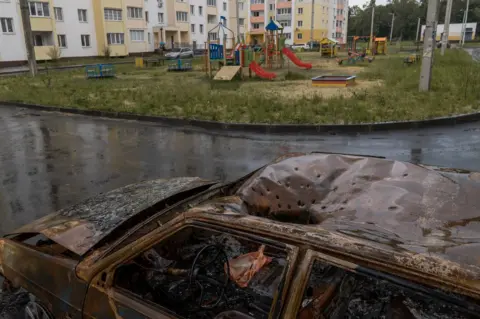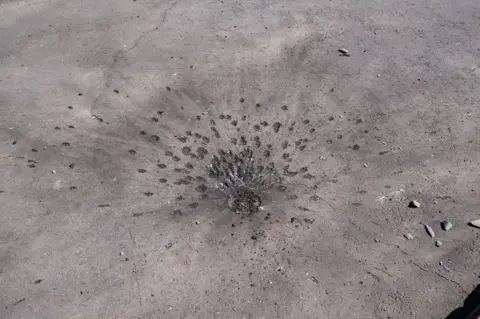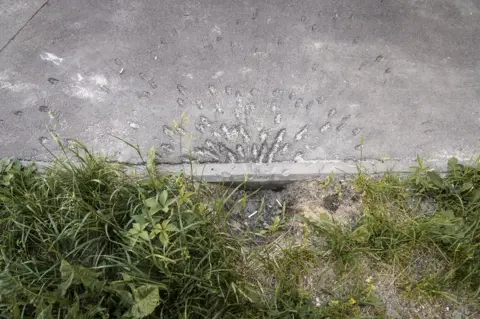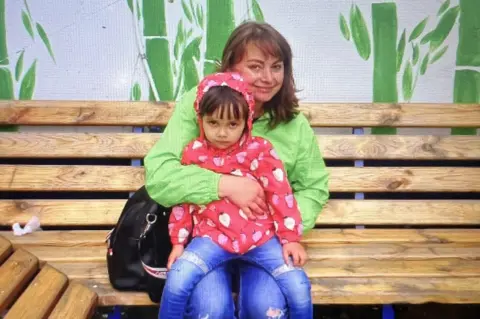Ukraine war: Evidence shows widespread use of cluster munitions in Kharkiv
 BBC
BBCRussia has killed hundreds of civilians in the north-eastern Ukrainian city of Kharkiv using indiscriminate shelling and widely-banned cluster munitions, according to new research by Amnesty International.
Amnesty said it had found evidence of Russian forces repeatedly using 9N210/9N235 cluster bombs, as well as "scatterable" munitions - rockets that eject smaller mines that explode later at timed intervals.
The BBC visited five separate impact sites in residential neighbourhoods in Kharkiv and saw evidence of a distinctive, symmetrical spalling effect associated with cluster munitions. We showed images from the sites to three weapons experts, who all said the impacts were consistent with the controversial weapons.
"Those impacts are from cluster munitions, it's a classic signature," said Mark Hizney, a senior researcher in the arms division of Human Rights Watch, a campaign group. "And in one image you can see a remnant of a stabiliser fin from one of the submunitions," he said.
CCTV footage passed to the BBC by a resident at one of the sites showed successive clustered detonations - "a very strong indicator of submunitions from a cluster weapon," said Hamish de Bretton Gordon, a former British Army colonel and Cambridge University weapons expert.

Cluster munitions are controversial because they detonate in the air and release a cluster of smaller bombs which fall indiscriminately over a wide area, potentially putting civilians at risk.
The smaller bombs also often fail to detonate on impact, posing a threat for years to come. More than 120 countries have signed a treaty prohibiting the use of the weapons - though neither Russia or Ukraine are signatories.
At the site of one apparent cluster munition strike in Kharkiv, around a housing estate and playground in the Industrialnyi neighbourhood, the spalling effect was visible around three separate impacts on three sides of a playground.
Ivan Litvynyenko's wife Oksana was badly wounded in the strike and later died.
Litvynyenko, 40, told the BBC the couple was walking through the playground with their five-year-old daughter when the munitions hit. Their 14-year-old son was inside their apartment.
"Suddenly I saw a flash and I heard the first explosion," Litvynyenko said. "I grabbed my daughter and pressed her to a tree. My wife was about five metres away and she just dropped."

Oksana, 41, was hit by shrapnel that penetrated her back, chest and abdomen, puncturing her lungs and damaging her spine.
She was in intensive care for two months, until Sunday, when she died from complications from her injuries and diabetes, Litvynyenko said. "Doctors operated on her several times but her body could not survive it," he said, speaking just hours after her death.
Describing the strike, Litvynyenko said he saw a "series of explosions, lots of bombs one after another". Two other residents who were inside their apartments at the time of the strike told the BBC they heard successive detonations when the attack happened. "You could hear explosions over several minutes," said Danya Volynets, 26. "When we came outside I could see the burning cars. It looked like everything was on fire."
Tetiana Ahayeva, a 53-year-old nurse, was standing in front of her building when the munitions hit. "There was a sudden sound of firecrackers everywhere, lots of them, all over," she told Amnesty. "We dropped to the ground and tried to find cover. Our neighbour's son, a 16-year-old boy called Artem Shevchenko, was killed on the spot. He had a hole 1cm wide in his chest. His father had a shattered hip and a shrapnel wound in his leg."

Doctors at a central Kharkiv hospital said that among the victims brought in after the playground strike they saw penetrating wounds to the abdomen, chest and back, and they collected metal fragments which matched the types of pellets found in 9N210/9N235 cluster munitions. According to Amnesty, the strike on the Industrialnyi neighbourhood killed at least nine civilians and wounded 35, detonating over an area of 700 square metres.
At another residential building, in Kharkiv's Haribaldi Street area, a munition landed in the entranceway to the building, killing two elderly women and gravely wounding another. The tell-tale spalling effect could be seen around the doorway and on the path nearby.
Tetiana Bielova and Olena Sorokina had been sitting on a bench outside when a munition detonated nearby. They got up to enter the building but a second munition landed right in the entranceway, killing Bielova and another woman called Tetiana who was with them. Sorokina lost both her legs in the blast.
"There was a series of explosions one after another," said resident Nadia Kravchuk, 61, who was in the building at the time. "I came out and saw a woman lying here face down and another other woman lying here, and next to them was Lena, who lost both her legs. She was crying out, 'I have lost my leg.'"

In total, over two weeks' field research, Amnesty investigated 41 strikes in Kharkiv in which at least 62 civilians were killed and 196 wounded, the charity said. They found evidence of cluster munitions and unguided rockets killing people who were shopping, queuing for food aid, or simply walking down the street.
"These weapons should never be used," Donatella Rovera, Amnesty's senior crisis response adviser, told the BBC. "They cannot be pinpointed. They are area weapons. And they have a devastating effect and cause a lot of civilian death and injury."
Use of the weapons was "tantamount to deliberately targeting civilians," Rovera said. "Russia cannot claim it does not know the effect of these types of weapons," she said. "And the decision to use them shows absolute disregard for civilian life."
Russia has previously denied using cluster munitions in Ukraine and insisted that Russian forces have only struck military targets.
